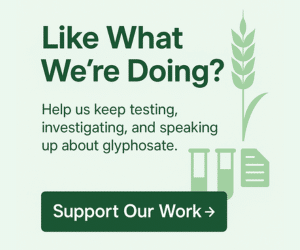When most people hear the word glyphosate, they think of Roundup®.
But here’s the catch: glyphosate and Roundup® aren’t the same thing.
Regulators, scientists, and the media often talk about glyphosate as if it exists in isolation — a single “active ingredient” that can be neatly tested, measured, and judged for safety.
In reality, nobody is spraying pure glyphosate on fields, roadsides, or backyards. What we’re exposed to are full formulations — chemical cocktails like Roundup® that mix glyphosate with surfactants, stabilizers, and other so-called “inert” ingredients. And those extras aren’t just bystanders. They can dramatically change how toxic the product is once it hits living systems, from soil microbes to human cells.
This is where the story gets troubling: our regulatory system tests glyphosate alone, but in the real world, people, animals, and ecosystems are dealing with the full brew. And science is showing that those hidden additives often make the final product more harmful than glyphosate ever was on its own.
The Problem with Testing Only the Active Ingredient
On paper, the system looks reassuring. Regulatory agencies around the world set safety limits for glyphosate, run toxicology tests, and decide how much exposure is considered “acceptable.” The trouble is, almost all of this testing is done on glyphosate alone — as if that’s what ends up in our soils, food, and bodies.
But that’s not how herbicides work in the real world. Roundup® and other glyphosate-based herbicides are sold as ready-to-use formulations. Alongside glyphosate, they contain a mix of co-formulants and surfactants designed to help the chemical stick to leaves, penetrate plant tissues, and stay stable on the shelf. These so-called “inert” ingredients are anything but inert when it comes to biological systems.
By ignoring the full formulation, regulators have created a dangerous blind spot. The toxicological profile of glyphosate by itself may look one way in a lab, but add the surfactants, and suddenly the mixture can become far more potent. That means the very product farmers spray, workers handle, and communities are exposed to is not the product that was tested and declared safe.
In short: the science regulators rely on doesn’t match the reality of what’s being used. And that disconnect has serious consequences for public health and environmental protection.
What the Research Shows
Over the past decade, independent researchers have taken a closer look at glyphosate-based herbicides and found a consistent pattern: the formulations are often more toxic than glyphosate alone. And it’s not just a matter of splitting hairs — these differences show up at concentrations well below regulatory thresholds.
Potential toxic effects of glyphosate and its commercial formulations below regulatory limits
Mesnage et al., 2015 (Food and Chemical Toxicology)
A review of multiple studies and found that adjuvants in glyphosate-based herbicides can amplify glyphosate’s effects. In some cases, the mixtures showed toxic effects at doses regulators would consider “safe.”
https://doi.org/10.1016/j.fct.2015.08.012
Insight into the confusion over surfactant co‑formulants in glyphosate‑based herbicides
Mesnage et al., 2019 (Toxicology)
This study dug deeper into surfactants like POEA, once common in Roundup® formulations, and showed they were significantly more toxic than glyphosate itself. This raises a troubling question: how many approvals were granted on the assumption that glyphosate was the only component that mattered?
https://doi.org/10.1016/j.fct.2019.03.053
Co‑Formulants in Glyphosate‑Based Herbicides Disrupt Aromatase Activity in Human Cells below Toxic Levels
Defarge et al., 2016 (International Journal of Environmental Research and Public Health)
This study found that hormone-disrupting effects in human cells were caused not by glyphosate alone, but by the co-formulants in herbicide mixtures. And the effects occurred at concentrations much lower than typical agricultural dilutions.
https://www.mdpi.com/1660-4601/13/3/264
Concerns over use of glyphosate‑based herbicides and risks associated with exposures: a consensus statement
Myers et al., 2016 (Environmental Health)
This paper pulled together the consensus: across species and study designs, glyphosate-based formulations repeatedly showed higher toxicity than glyphosate in isolation.
https://doi.org/10.1186/s12940-016-0117-0
The takeaway is hard to ignore. When you test glyphosate by itself, you miss the real-world picture. It’s the combination — the supposedly “inert” additives plus glyphosate — that people, wildlife, and ecosystems are exposed to. And that combination is proving to be more harmful than the single ingredient regulators focus on.
Why This Matters
It might sound like a technical detail — testing glyphosate alone versus testing the full product. But this distinction makes all the difference when it comes to real-world safety.
Workers applying herbicides, families living near sprayed areas, and consumers eating food grown with glyphosate aren’t exposed to pure glyphosate. They’re exposed to Roundup® and similar formulations — chemical mixtures that behave very differently inside living systems. By ignoring the role of surfactants and co-formulants, regulators consistently underestimate the risks.
This loophole doesn’t just put people at risk; it also weakens environmental protection. Soil organisms, aquatic life, pollinators, and wildlife are all exposed to the same chemical cocktails. If the formulations are more toxic than glyphosate alone, then the ecological impact is also far greater than official assessments admit.
In short, the science is clear: the real-world product is more hazardous than the one regulators are measuring. And until that gap is closed, the public is being misled with assurances of safety that don’t reflect reality.
What It Means for New Zealand
In New Zealand, Roundup® and other glyphosate-based herbicides are everywhere. They’re sprayed on farms before planting and at harvest, on roadside verges, in forestry operations, in parks, and even around schools and playgrounds. For many councils and contractors, it’s the go-to weed control tool.
Yet, like most countries, our regulatory system only looks at glyphosate in isolation when assessing safety. The Environmental Protection Authority (EPA) leans heavily on international studies that test glyphosate as a single active ingredient — not the full formulations New Zealanders are actually exposed to. This means the co-formulants, which science has shown can amplify toxicity and trigger hormone disruption, slip through the cracks.
The result? Farmers, families, and ecosystems are left vulnerable. Communities are reassured that glyphosate is “safe,” but the product on the shelf — Roundup® — is something very different. Until regulators start requiring safety tests on the full formulations, New Zealanders are living with an incomplete and misleading picture of the risks.
The Safety Illusion
Glyphosate may get the headlines, but it’s the hidden extras in Roundup® that often tip the balance from questionable to outright dangerous. Science has been sounding the alarm for years: formulations are consistently more toxic than glyphosate alone, and yet regulators continue to treat the co-formulants as if they don’t exist.
In New Zealand, that blind spot has very real consequences. Our communities are surrounded by glyphosate-based herbicides, from farmland to playgrounds, while regulators reassure us with data that doesn’t reflect what’s actually being sprayed. It’s probably no coincidence that New Zealand has some of the highest rates of Non-Hodgkin Lymphoma in the world — a disease repeatedly linked to glyphosate exposure in international courts and scientific studies.
Until our regulatory system catches up with the science, claims of “safety” don’t carry much weight. What matters is not the laboratory version of glyphosate, but the full chemical cocktail being used in the real world. And right now, that cocktail is being tested on us all.
The real experiment isn’t in the lab — it’s happening in our food, our soil, and our bodies.
Resources & References
When regulators and industry point to glyphosate’s “safety,” they’re often talking about glyphosate in isolation. But people, animals, and ecosystems are exposed to the full chemical cocktails — and the science shows those mixtures can be far more harmful. Below are key studies that highlight why Roundup® formulations raise deeper concerns.
Key scientific evidence
Mesnage et al., 2015 — Food and Chemical Toxicology
Glyphosate-based herbicide formulations were found to be toxic below regulatory limits, due to adjuvants amplifying glyphosate’s effects.
https://pubmed.ncbi.nlm.nih.gov/26282372/
Mesnage et al., 2019 — Toxicology
Identified POEA surfactants in Roundup® as significantly more toxic than glyphosate alone, raising questions about regulatory approvals.
https://pubmed.ncbi.nlm.nih.gov/30951798/
Defarge et al., 2016 — International Journal of Environmental Research and Public Health
Showed that co-formulants — not glyphosate itself — triggered hormone disruption in human cells at very low concentrations.
https://www.mdpi.com/1660-4601/13/3/264
Myers et al., 2016 — Environmental Health
A consensus review confirming glyphosate-based formulations are consistently more toxic than glyphosate alone across species.
https://ehjournal.biomedcentral.com/articles/10.1186/s12940-016-0117-0
Related article on NoMoreGlyphosate.nz
The Cancer We Can’t Keep Ignoring — (June 12, 2025)
An in-depth look at the Ramazzini Institute’s findings on long-term glyphosate exposure and cancer risks.
https://nomoreglyphosate.nz/glyphosate-evidence-impact/
Together, these studies point to a simple but unsettling truth: glyphosate’s reputation for “safety” rests on tests that ignore the very mixtures people are actually exposed to. Until regulators catch up with the science, the real question isn’t whether glyphosate is safe — it’s how much risk we’re willing to tolerate when the evidence says the full story is being left out.
Image Source & Attribution
We’re grateful to the talented photographers and designers whose work enhances our content. The feature image on this page is by madvideos.gmail.com.




